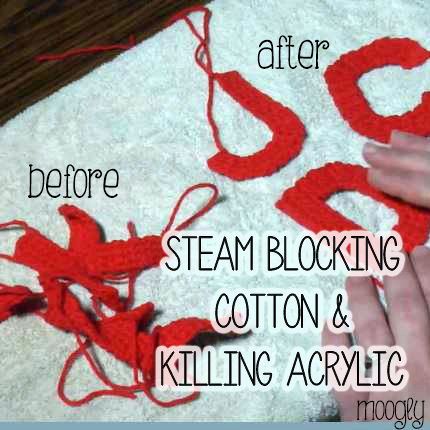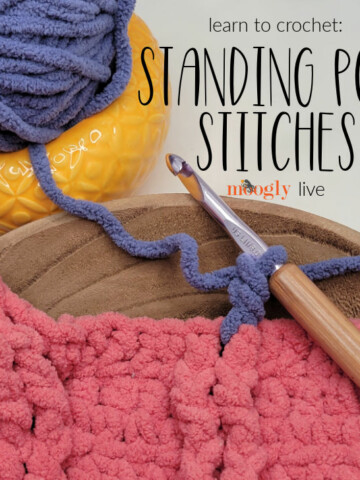Blocking knit and crochet projects is something that a lot of people don't do - and usually that's just fine! While many projects would benefit from some blocking, lots do just fine without it.
However, there are times when blocking is definitely required. Lacey items, thread work like doilies and snowflakes, and small projects that curl up all benefit greatly. Blocking lace and thread lets you see the pattern, and in the case of snowflakes it's done with glue - making that shape and pattern permanent! You can also block items by just getting them wet and shaping them to dry, like you would with a favorite sweater.
The method I want to show you here is Steam Blocking for Cotton and Acrylic. This method can be gentle or "hard." Depending on how you handle your iron you can get very different results. A light touch, just holding the steam right above your items gives you a gentle, relaxed block. You can shape and reshape and work with your fabric to get it right.
This video, on the other hand, demonstrates a much harder, definite blocking technique. It works great on cotton, and it's also how you kill acrylic! It's one of my favorite things to do to really change up the look of a finished item, and here's how it's done.
Video Tutorial: Steam Blocking and Killing Acrylic
The most important thing is to keep that wet towel on there! With your soaking wet (but not quite dripping) towel and a hot iron, you'll be all set to start blocking things like the letters shown here. Blocking cotton like this is so much fun - and the results are immediate! I blocked an entire alphabet in just a few minutes. Just keep wetting the towel, and don't be afraid to reshape and re-steam.
I've also done a photo tutorial on killing acrylic if you want more information on that technique. Killing acrylic is permanent, so play around with a swatch before you start in on a finished item. Lightly steaming the acrylic keeps the texture of the yarn, but it's a very very fine line between steaming and killing. I've accidentally gone too far before myself, and I know the heartbreak of melting acrylic when I didn't mean to.
I hope this has given you the courage to try this technique out! This is the perfect technique for blocking The Moogly Crochet Alphabet if you're using cotton - instant gratification and they look SO much better for it. Thanks for watching!
Be sure to check out and like the moogly Facebook page to get the latest updates, links, and sneak peeks. Moogly is also on Pinterest, Twitter, Tumblr, and Google+ – come join the fun! You can contact me via the Facebook page or at TamaraKelly@mooglyblog.com.







Lorie
wow, that was so cool!
could this be done with 100% wool yarn? (the blocking, not the killing!)
Tamara Kelly
As long as it's 100% wool it should work! I'd definitely try it with a small swatch before a finished project though, just to be absolutely sure how that specific yarn will react!
Lorie
Thanks!
I love your video tutorials!
Linda
Is the killed acrylic still washable, as it would be prior to killing it?
I have a bib made from acrylic that has been washed and dried in hot temps numerous times. Do you think it could still be killed like this?
Tamara Kelly
It's definitely still washable! Just not froggable! 🙂
Heather COleman
Hi! I have a really quick question. I am making a crochet sweater for my daughter, who just turned a year. The sweater is a 24 month pattern that will fit quite nicely, but I"m wondering if I should block it. It is a cotton/acrylic blend and used the basketweave pattern on the bottom half. Does wet blocking work for such material? I feel like blocking it might give her the little extra added space to make it a little roomier.
Thanks in advance for your time and I'm a HUGE fan of your site!
Heather Coleman
Tamara Kelly
Hi Heather! It won't block to be a whole lot bigger, but blocking will help set the stitches and make them look a little nicer. 😀
Virginia
I saw the video and just have one question.... after 'blocking' the acrylic, was it soft?? Someone wants to pick up an order which hasnt been blocked, they want it now though. I dont feel right not blocking it and was thinking maybe this would do it but... im mainly looking to get it soft (yarn wasnt soft and didnt wash to soften beforehand) :/. I just want to know if it was soft. Ugh, may just tell them theyll have to wait. They're verry inpatient :/
Tamara Kelly
Blocking can improve drape, and sometimes softness too! If it's very rough, you can put some conditioner in the water you wet it with, to make it even softer. 🙂
Kristen
Hello!! I'm just about finished with a shawl in Patons Grace mercerized cotton yarn. I'm unsure of the best way to block but feel like it needs something. Any suggestions would be wonderful!
Thanks,
Kristen
Tamara Kelly
Hi Kristen! For that yarn, I would get it very wet and then gently squeeze out the excess water by rolling it in a towel. Then I would lay it flat, shaping it as you go, and pinning it if needed. Let it air dry, and that's it!
Kristen
Thank you so much!!
Dusty bennett
Tamara, Is it necessary to block a baby afghan? It's made with 100% cotton Nova Plus yarn.
Tamara Kelly
Only if you feel it could be improved upon in terms of shaping and how it lays. If you like the way it comes off the hook, then you're all set! 🙂
Kathy
After crocheting a single crochet edge on my Afghan on one side in a couple of areas it curled. I used 100%ncotton yarn. Would blocking with steam make it lay flat?
Tamara Kelly
It will help - it just depends how *much* curling you have as to whether you'll be able to get it flat. It sounds like perhaps a few too many stitches are the culprit. 🙂
Kathy
It's where the beginning chain is. I crochet tight I was wondering if that is the problem. It didn't happen on the other end. I just got done taking the edging out and I don't want it to happen again.
Thanks for any advice!😃